Application of SWAT Using Snow Data and Detecting Climate Change Impacts in the Mountainous Eastern Regions of Turkey
Abstract
:1. Introduction
2. Materials and Data
2.1. Study Area
2.2. SWAT Model
2.3. Model Inputs
3. Modelling Studies and Results
3.1. Base Model Setup
3.2. Snow Parameters Fitting Procedure
3.3. Flow-Sensitivity Analysis, Calibration, Validation and Water Balance
3.4. Snow Validation with Ground and Satellite Data
3.5. Climate Change Impacts
4. Conclusions
Author Contributions
Funding
Institutional Review Board Statement
Informed Consent Statement
Data Availability Statement
Acknowledgments
Conflicts of Interest
References
- Viviroli, D.; Weingartner, R. The Significance of Mountains as Sources of the World’s Fresh Water. GAIA Ecol. Perspect. Sci. Soc. 2002, 11, 182–186. [Google Scholar] [CrossRef]
- Adam, J.C.; Hamlet, A.F.; Lettenmaier, D.P. Implications of global climate change for snowmelt hydrology in the twenty-first century. Hydrol. Process. 2009, 23, 962–972. [Google Scholar] [CrossRef]
- Viviroli, D.; Dürr, H.H.; Messerli, B.; Meybeck, M.; Weingartner, R. Mountains of the world, water towers for humanity: Typology, mapping, and global significance. Water Resour. Res. 2007, 43. [Google Scholar] [CrossRef] [Green Version]
- Milano, M.; Reynard, E.; Köplin, N.; Weingartner, R. Climatic and anthropogenic changes in Western Switzerland: Impacts on water stress. Sci. Total Environ. 2015, 536, 12–24. [Google Scholar] [CrossRef] [PubMed]
- Immerzeel, W.W.; Lutz, A.F.; Andrade, M.; Bahl, A.; Biemans, H.; Bolch, T.; Hyde, S.; Brumby, S.; Davies, B.; Elmore, A.C.; et al. Importance and vulnerability of the world’s water towers. Nat. Cell Biol. 2020, 577, 364–369. [Google Scholar] [CrossRef]
- Pradhanang, S.M.; Anandhi, A.; Mukundan, R.; Zion, M.S.; Pierson, D.C.; Schneiderman, E.M.; Matonse, A.; Frei, A. Application of SWAT model to assess snowpack development and streamflow in the Cannonsville watershed, New York, USA. Hydrol. Process. 2011, 25, 3268–3277. [Google Scholar] [CrossRef]
- Butt, M.J.; Bilal, M. Application of snowmelt runoff model for water resource management. Hydrol. Process. 2011, 25, 3735–3747. [Google Scholar] [CrossRef]
- Seidel, K.; Brusch, W.; Steinmeier, C. Experiences from real time runoff forecasts by snow cover remote sensing. IEEE Int. Geosci. Remote Sens. Symp. 2002, 4, 2090–2093. [Google Scholar] [CrossRef]
- Rango, A. Spaceborne remote sensing for snow hydrology applications. Hydrol. Sci. J. 1996, 41, 477–494. [Google Scholar] [CrossRef]
- Grayson, R.B.; Bloschl, G.; Western, A.W.; McMahon, T.A. Advances in the use of observed spatial patterns of catchment hydrological response. Adv. Water Resour. 2002, 25, 1313–1334. [Google Scholar] [CrossRef]
- Parajka, J.; Bloschl, G. Spatio-temporal combination of MODIS images—Potential for snow cover mapping. Water Resour. Res. 2008, 44, 03406. [Google Scholar] [CrossRef]
- Şorman, A.A.; Sensoy, A.; Tekeli, A.E.; Sorman, A.U.; Akyürek, Z. Modelling and forecasting snowmelt runoff process using the HBV model in the eastern part of Turkey. Hydrol. Process. 2009, 23, 1031–1040. [Google Scholar] [CrossRef]
- Hancock, S.; Baxter, R.; Evans, J.; Huntley, B. Evaluating global snow water equivalent products for testing land surface models. Remote Sens. Environ. 2013, 128, 107–117. [Google Scholar] [CrossRef] [Green Version]
- Grusson, Y.; Sun, X.; Gascoin, S.; Sauvage, S.; Raghavan, S.; Anctil, F.; Sáchez-Pérez, J.-M. Assessing the capability of the SWAT model to simulate snow, snow melt and streamflow dynamics over an alpine watershed. J. Hydrol. 2015, 531, 574–588. [Google Scholar] [CrossRef]
- Yılmaz, Y.A.; Aalstad, K.; Sen, O.L. Multiple Remotely Sensed Lines of Evidence for a Depleting Seasonal Snowpack in the Near East. Remote Sens. 2019, 11, 483. [Google Scholar] [CrossRef] [Green Version]
- IPCC. Climate Change 2014: Synthesis Report. Contribution of Working Groups I, II and III to the Fifth Assessment Report of the Intergovernmental Panel on Climate Change; Pachauri, R.K., Meyer, L.A., Eds.; IPCC: Geneva, Switzerland, 2014; p. 151. [Google Scholar]
- Stewart, I.T.; Cayan, D.R.; Dettinger, M.D. Changes toward Earlier Streamflow Timing across Western North America. J. Clim. 2005, 18, 1136–1155. [Google Scholar] [CrossRef]
- Bozkurt, D.; Sen, O.L. Climate change impacts in the Euphrates–Tigris Basin based on different model and scenario simulations. J. Hydrol. 2013, 480, 149–161. [Google Scholar] [CrossRef]
- Yucel, I.; Güventürk, A.; Sen, O.L. Climate change impacts on snowmelt runoff for mountainous transboundary basins in eastern Turkey. Int. J. Clim. 2014, 35, 215–228. [Google Scholar] [CrossRef]
- Arnold, J.G.; Srinivasan, R.; Muttiah, R.S.; Williams, J.R. Large area hydrologic modeling and assessment part I: Model development. J. Am. Water Resour. Assoc. 1998, 34, 73–89. [Google Scholar] [CrossRef]
- Abbaspour, K.C.; Rouholahnejad, E.; Vaghefi, S.; Srinivasan, R.; Yang, H.; Kløve, B. A continental-scale hydrology and water quality model for Europe: Calibration and uncertainty of a high-resolution large-scale SWAT model. J. Hydrol. 2015, 524, 733–752. [Google Scholar] [CrossRef] [Green Version]
- Gassman, P.W.; Reyes, M.R.; Green, C.H.; Arnold, J.G. The Soil and Water Assessment Tool: Historical Development, Applications, and Future Research Directions. Trans. ASABE 2007, 50, 1211–1250. [Google Scholar] [CrossRef] [Green Version]
- Gassman, P.W.; Sadeghi, A.M.; Srinivasan, R. Applications of the SWAT Model Special Section: Overview and Insights. J. Environ. Qual. 2014, 43, 1–8. [Google Scholar] [CrossRef] [PubMed]
- Tan, M.L.; Gassman, P.W.; Yang, X.; Haywood, J. A review of SWAT applications, performance and future needs for simulation of hydro-climatic extremes. Adv. Water Resour. 2020, 143, 103662. [Google Scholar] [CrossRef]
- Arnold, J.G.; Srinivasan, R.; Muttiah, R.S.; Allen, P.M. Continental scale simulation of the hydrologic balance. J. Am. Water Resour. Assoc. 1999, 35, 1037–1051. [Google Scholar] [CrossRef]
- Fontaine, T.; Cruickshank, T.; Arnold, J.; Hotchkiss, R. Development of a snowfall—Snowmelt routine for mountainous terrain for the soil water assessment tool (SWAT). J. Hydrol. 2002, 262, 209–223. [Google Scholar] [CrossRef]
- Wang, X.; Melesse, A. Evaluation of the swat model’s snowmelt hydrology in a northwestern minnesota watershed. Trans. ASAE 2005, 48, 1359–1376. [Google Scholar] [CrossRef]
- Ahl, R.S.; Woods, S.W.; Zuuring, H.R. Hydrologic Calibration and Validation of SWAT in a Snow-Dominated Rocky Mountain Watershed, Montana, USA. J. Am. Water Resour. Assoc. 2008, 44, 1411–1430. [Google Scholar] [CrossRef]
- Kang, K.; Lee, J.H. Hydrologic modelling of the effect of snowmelt and temperature on a mountainous watershed. J. Earth Syst. Sci. 2014, 123, 705–713. [Google Scholar] [CrossRef] [Green Version]
- Tuo, Y.; Marcolini, G.; Disse, M.; Chiogna, G. Calibration of snow parameters in SWAT: Comparison of three approaches in the Upper Adige River basin (Italy). Hydrol. Sci. J. 2018, 63, 657–678. [Google Scholar] [CrossRef]
- Troin, M.; Caya, D. Evaluating the SWAT’s snow hydrology over a Northern Quebec watershed. Hydrol. Process. 2013, 28, 1858–1873. [Google Scholar] [CrossRef]
- Dhami, B.; Himanshu, S.K.; Pandey, A.; Gautam, A.K. Evaluation of the SWAT model for water balance study of a mountainous snowfed river basin of Nepal. Environ. Earth Sci. 2018, 77, 21. [Google Scholar] [CrossRef]
- Stehr, A.; Debels, P.; Arumí, J.L.; Romero, F.; Alcayaga, H. Combining the Soil and Water Assessment Tool (SWAT) and MODIS imagery to estimate monthly flows in a data-scarce Chilean Andean basin. Hydrol. Sci. J. 2009, 54, 1053–1067. [Google Scholar] [CrossRef]
- Abbaspour, K.C.; Faramarzi, M.; Ghasemi, S.S.; Yang, H. Assessing the impact of climate change on water resources in Iran. Water Resour. Res. 2009, 45, 10434. [Google Scholar] [CrossRef] [Green Version]
- Grusson, Y.; Anctil, F.; Sauvage, S.; Pérez, J.M.S. Coevolution of Hydrological Cycle Components under Climate Change: The Case of the Garonne River in France. Water 2018, 10, 1870. [Google Scholar] [CrossRef] [Green Version]
- Čerkasova, N.; Ertürk, A.; Zemlys, P.; Denisov, V.; Umgiesser, G. Curonian Lagoon drainage basin modelling and assessment of climate change impact. Oceanologia 2016, 58, 90–102. [Google Scholar] [CrossRef] [Green Version]
- Saddique, N.; Usman, M.; Bernhofer, C. Simulating the Impact of Climate Change on the Hydrological Regimes of a Sparsely Gauged Mountainous Basin, Northern Pakistan. Water 2019, 11, 2141. [Google Scholar] [CrossRef] [Green Version]
- Borah, D.K.; Bera, M. Watershed-scale hydrologic and nonpoint-source pollution models: Review of mathematical bases. Trans. ASAE 2003, 46, 1553–1566. [Google Scholar] [CrossRef] [Green Version]
- Golmohammadi, G.; Prasher, S.; Madani, A.; Rudra, R. Evaluating Three Hydrological Distributed Watershed Models: MIKE-SHE, APEX, SWAT. Hydrology 2014, 1, 20–39. [Google Scholar] [CrossRef] [Green Version]
- Krysanova, V.; Arnold, J.G. Advances in ecohydrological modelling with SWAT—A review. Hydrol. Sci. J. 2008, 53, 939–947. [Google Scholar] [CrossRef]
- Krysanova, V.; White, M. Advances in water resources assessment with SWAT—An overview. Hydrol. Sci. J. 2015, 60, 1–13. [Google Scholar] [CrossRef] [Green Version]
- Ekdal, A.; Gurel, M.; Guzel, C.; Erturk, A.; Tanik, A.; Gonenc, I.E. Application of WASP and SWAT models for a mediterranean coastal lagoon with limited seawater exchange. J. Coast. Res. 2011, S1, 1023–1027. [Google Scholar]
- Özcan, Z.; Kentel, E.; Alp, E. Evaluation of the best management practices in a semi-arid region with high agricultural activity. Agric. Water Manag. 2017, 194, 160–171. [Google Scholar] [CrossRef]
- Gungor, O.; Göncü, S. Application of the soil and water assessment tool model on the Lower Porsuk Stream Watershed. Hydrol. Process. 2013, 27, 453–466. [Google Scholar] [CrossRef]
- Ertürk, A.; Ekdal, A.; Gürel, M.; Karakaya, N.; Guzel, C.; Gönenç, E. Evaluating the impact of climate change on groundwater resources in a small Mediterranean watershed. Sci. Total Environ. 2014, 499, 437–447. [Google Scholar] [CrossRef]
- Cuceloglu, G.; Abbaspour, K.C.; Ozturk, I. Assessing the Water-Resources Potential of Istanbul by Using a Soil and Water Assessment Tool (SWAT) Hydrological Model. Water 2017, 9, 814. [Google Scholar] [CrossRef] [Green Version]
- Cuceloglu, G.; Ozturk, I. Assessing the Impact of CFSR and Local Climate Datasets on Hydrological Modeling Performance in the Mountainous Black Sea Catchment. Water 2019, 11, 2277. [Google Scholar] [CrossRef] [Green Version]
- CORINE Land Cover. Copernicus Land Monitoring Service; CORINE Land Cover: Copenhagen, Denmark, 2000; Available online: https://land.copernicus.eu/pan-european/corine-land-cover (accessed on 3 May 2021).
- Food and Agriculture Organization of the United Nations. FAO Digital Soil Map of the World (DSMW). Available online: http://www.fao.org/geonetwork/srv/ (accessed on 24 October 2020).
- Bieger, K.; Arnold, J.G.; Rathjens, H.; White, M.J.; Bosch, D.D.; Allen, P.M.; Volk, M.; Srinivasan, R. Introduction to SWAT+, A Completely Restructured Version of the Soil and Water Assessment Tool. J. Am. Water Resour. Assoc. 2016, 53, 115–130. [Google Scholar] [CrossRef]
- Arnold, J.G.; Williams, J.R. Validation of SWRRB—Simulator for Water Resources in Rural Basins. J. Water Resour. Plan. Manag. 1987, 113, 243–256. [Google Scholar] [CrossRef]
- Williams, J.R.; Arnold, J.G.; Kiniry, J.R.; Gassman, P.W.; Green, C.H. History of model development at Temple, Texas. Hydrol. Sci. J. 2008, 53, 948–960. [Google Scholar] [CrossRef] [Green Version]
- Douglas-Mankin, K.R.; Srinivasan, R.; Arnold, J.G. Soil and Water Assessment Tool (SWAT) Model: Current Developments and Applications. Trans. ASABE 2010, 53, 1423–1431. [Google Scholar] [CrossRef]
- Tuppad, P.; Douglas-Mankin, K.R.; Lee, T.; Srinivasan, R.; Arnold, J.G. Soil and Water Assessment Tool (SWAT) Hydrologic/Water Quality Model: Extended Capability and Wider Adoption. Trans. ASABE 2011, 54, 1677–1684. [Google Scholar] [CrossRef]
- Arnold, J.G.; Fohrer, N. SWAT2000: Current capabilities and research opportunities in applied watershed modelling. Hydrol. Process. 2005, 19, 563–572. [Google Scholar] [CrossRef]
- Neitsch, S.L.; Arnold, J.G.; Kiniry, J.R.; Williams, J.R. Soil and Water Assessment Tool Theoretical Documentation Version 2009; Texas Water Resources Institute: Forney, TX, USA, 2011; pp. 1–618. [Google Scholar]
- Arnold, J.G.; Moriasi, D.N.; Gassman, P.W.; Abbaspour, K.C.; White, M.J.; Srinivasan, R.; Santhi, C.; Harmel, R.D.; van Griensven, A.; Van Liew, M.W.; et al. SWAT: Model Use, Calibration, and Validation. Trans. ASABE 2012, 55, 1491–1508. [Google Scholar] [CrossRef]
- Zhang, X.; Srinivasan, R.; Debele, B.; Hao, F. Runoff Simulation of the Headwaters of the Yellow River Using The SWAT Model With Three Snowmelt Algorithms1. J. Am. Water Resour. Assoc. 2008, 44, 48–61. [Google Scholar] [CrossRef]
- Luo, Y.; Arnold, J.; Allen, P.; Chen, X. Baseflow simulation using SWAT model in an inland river basin in Tianshan Mountains, Northwest China. Hydrol. Earth Syst. Sci. 2012, 16, 1259–1267. [Google Scholar] [CrossRef] [Green Version]
- Rahman, K.; Maringanti, C.; Beniston, M.; Widmer, F.; Abbaspour, K.; Lehmann, A. Streamflow Modeling in a Highly Managed Mountainous Glacier Watershed Using SWAT: The Upper Rhone River Watershed Case in Switzerland. Water Resour. Manag. 2012, 27, 323–339. [Google Scholar] [CrossRef] [Green Version]
- Tuo, Y.; Marcolini, G.; Disse, M.; Chiogna, G. A multi-objective approach to improve SWAT model calibration in alpine catchments. J. Hydrol. 2018, 559, 347–360. [Google Scholar] [CrossRef]
- Shuttle Radar Topography Mission (SRTM). SRTM 90m DEM Digital Elevation Database. Available online: https://srtm.csi.cgiar.org/ (accessed on 21 June 2021).
- Fuka, D.R.; Walter, M.T.; MacAlister, C.; DeGaetano, A.T.; Steenhuis, T.S.; Easton, Z.M. Using the Climate Forecast System Reanalysis as weather input data for watershed models. Hydrol. Process. 2014, 28, 5613–5623. [Google Scholar] [CrossRef]
- MODerate Resolution Imaging Spectroradiometer (MODIS). Available online: https://modis.gsfc.nasa.gov/ (accessed on 21 June 2021).
- Sorman, A.A.; Yamankurt, E. Modified satellite products on snow covered area in upper Euphrates basin, Turkey. Geophys. Res. Abstr. 2011, 13, EGU2011-7887. [Google Scholar]
- Jha, M.; Gassman, P.W.; Secchi, S.; Gu, R.; Arnold, J. Effect of watershed subdivision on SWAT flow, sediment, and nutrient predictions. J. Am. Water Resour. Assoc. 2004, 40, 811–825. [Google Scholar] [CrossRef] [Green Version]
- Winchell, M.; Srinivasan, R.; Di Luzio, M.; Arnold, J. ArcSWAT Interface for SWAT2012: User’s Guide; Blackland Research and Extension Center, Texas AgriLife Research, and USDA-ARS Grassland, Soil, and Water Research Laboratory: Temple, TX, USA, 2013. [Google Scholar]
- Abbaspour, K.C.; Vejdani, M.; Haghighat, S. SWAT-CUP Calibration and Uncertainty Programs for SWAT. In Proceedings of the Fourth International SWAT Conference 2007, Delft, The Netherlands, 4–6 July 2007; pp. 1596–1602. [Google Scholar]
- Abbaspour, K.C.; Vaghefi, S.A.; Srinivasan, R. A Guideline for Successful Calibration and Uncertainty Analysis for Soil and Water Assessment: A Review of Papers from the 2016 International SWAT Conference. Water 2017, 10, 6. [Google Scholar] [CrossRef] [Green Version]
- Dressler, K.A.; Leavesley, G.H.; Bales, R.C.; Fassnacht, S.R. Evaluation of gridded snow water equivalent and satellite snow cover products for mountain basins in a hydrologic model. Hydrol. Process. 2006, 20, 673–688. [Google Scholar] [CrossRef]
- Shamir, E.; Georgakakos, K.P. Estimating snow depletion curves for American River basins using distributed snow modeling. J. Hydrol. 2007, 334, 162–173. [Google Scholar] [CrossRef]
- Molotch, N.P.; Margulis, S.A. Estimating the distribution of snow water equivalent using remotely sensed snow cover data and a spatially distributed snowmelt model: A multi-resolution, multi-sensor comparison. Adv. Water Resour. 2008, 31, 1503–1514. [Google Scholar] [CrossRef]
- Franz, K.; Karsten, L.R. Calibration of a distributed snow model using MODIS snow covered area data. J. Hydrol. 2013, 494, 160–175. [Google Scholar] [CrossRef]
- Skaugen, T.; Randen, F. Modeling the spatial distribution of snow water equivalent, taking into account changes in snow-covered area. Ann. Glaciol. 2013, 54, 305–313. [Google Scholar] [CrossRef] [Green Version]
- Rittger, K.; Bair, E.H.; Kahl, A.; Dozier, J. Spatial estimates of snow water equivalent from reconstruction. Adv. Water Resour. 2016, 94, 345–363. [Google Scholar] [CrossRef] [Green Version]
- Riboust, P.; Thirel, G.; Le Moine, N.; Ribstein, P. Revisiting a Simple Degree-Day Model for Integrating Satellite Data: Implementation of Swe-Sca Hystereses. J. Hydrol. Hydromech. 2019, 67, 70–81. [Google Scholar] [CrossRef] [Green Version]
- Uysal, G.; Sensoy, A.; Şorman, A.A. Improving daily streamflow forecasts in mountainous Upper Euphrates basin by multi-layer perceptron model with satellite snow products. J. Hydrol. 2016, 543, 630–650. [Google Scholar] [CrossRef]
- Sorman, A.A.; Sensoy, A.; Coskun, C. Use of different satellite snow products in short term hydrological forecasting. In Proceedings of the EU-METSAT Meteorological Satellite Conference 2017, Rome, Italy, 2–6 October 2017. [Google Scholar]
- Şorman, A.A.; Uysal, G.; Şensoy, A. Probabilistic Snow Cover and Ensemble Streamflow Estimations in the Upper Euphrates Basin. J. Hydrol. Hydromech. 2019, 67, 82–92. [Google Scholar] [CrossRef] [Green Version]
- McKay, M.D.; Beckman, R.J.; Conover, W.J. Comparison of Three Methods for Selecting Values of Input Variables in the Analysis of Output from a Computer Code. Technometrics 1979, 21, 239–245. [Google Scholar] [CrossRef]
- Moriasi, D.N.; Arnold, J.G.; Van Liew, M.W.; Bingner, R.L.; Harmel, R.D.; Veith, T.L. Model Evaluation Guidelines for Systematic Quantification of Accuracy in Watershed Simulations. Trans. ASABE 2007, 50, 885–900. [Google Scholar] [CrossRef]
- Demircan, M.; Demir, Ö.; Atay, H.; Yazici, B.; Eskioğlu, O.; Tuvan, A.; Akçakaya, A. Climate change projections for Turkey with new scenarios. In Proceedings of the Climate Change and Climate Dynamics Conference—CCCD 2014, Istanbul, Turkey, 8–10 September 2014. [Google Scholar]
- Demircan, M.; Gürkan, H.; Eskioğlu, O.; Arabacı, H.; Coşkun, M. Climate Change Projections for Turkey: Three Models and Two Scenarios. Turk. J. Water Sci. Manag. 2017, 1, 22–43. [Google Scholar] [CrossRef]
- Önol, B.; Bozkurt, D.; Turuncoglu, U.U.; Şen, Ö.L.; Dalfes, H.N.; Dalfes, N. Evaluation of the twenty-first century RCM simulations driven by multiple GCMs over the Eastern Mediterranean–Black Sea region. Clim. Dyn. 2013, 42, 1949–1965. [Google Scholar] [CrossRef]
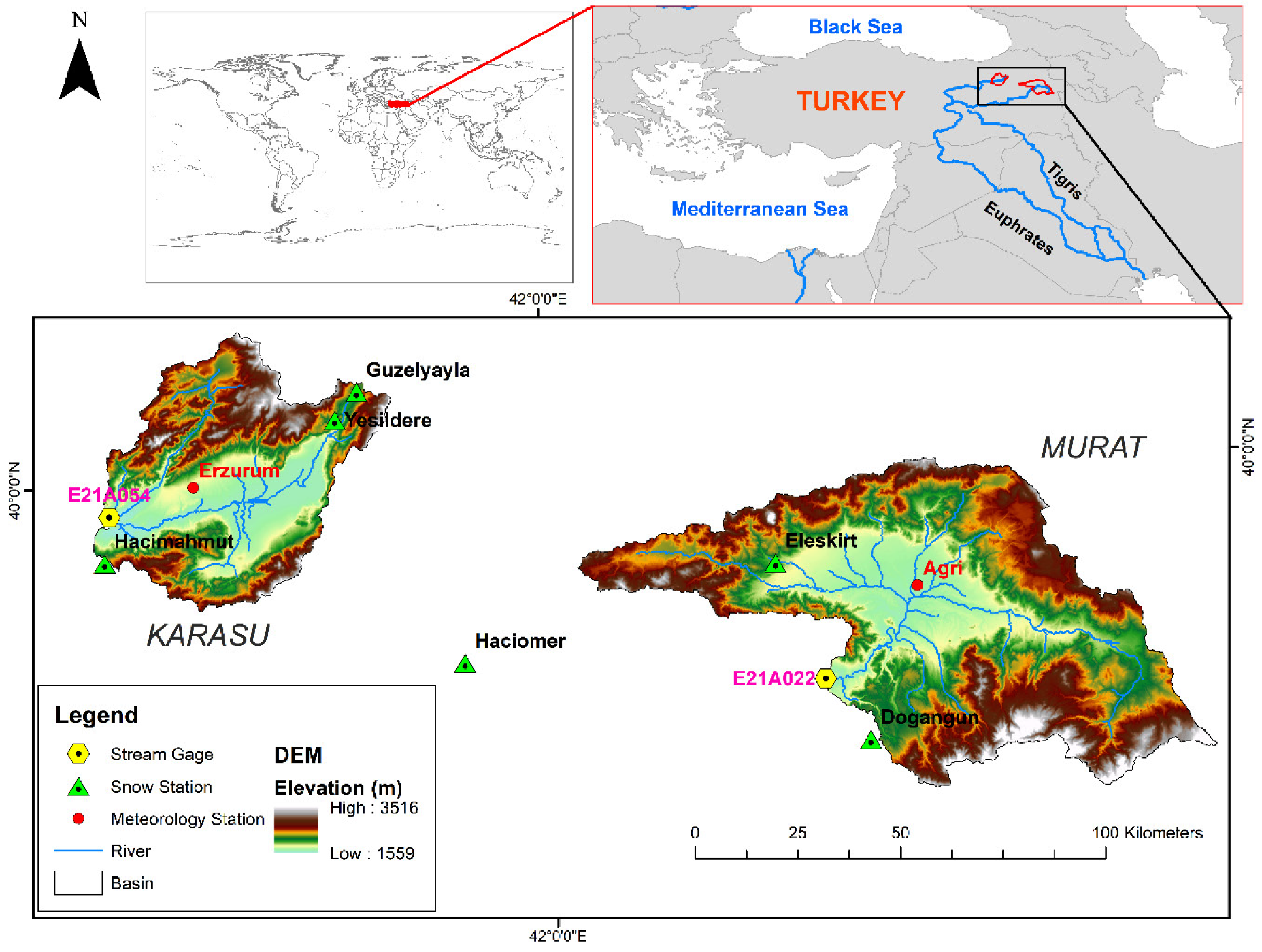

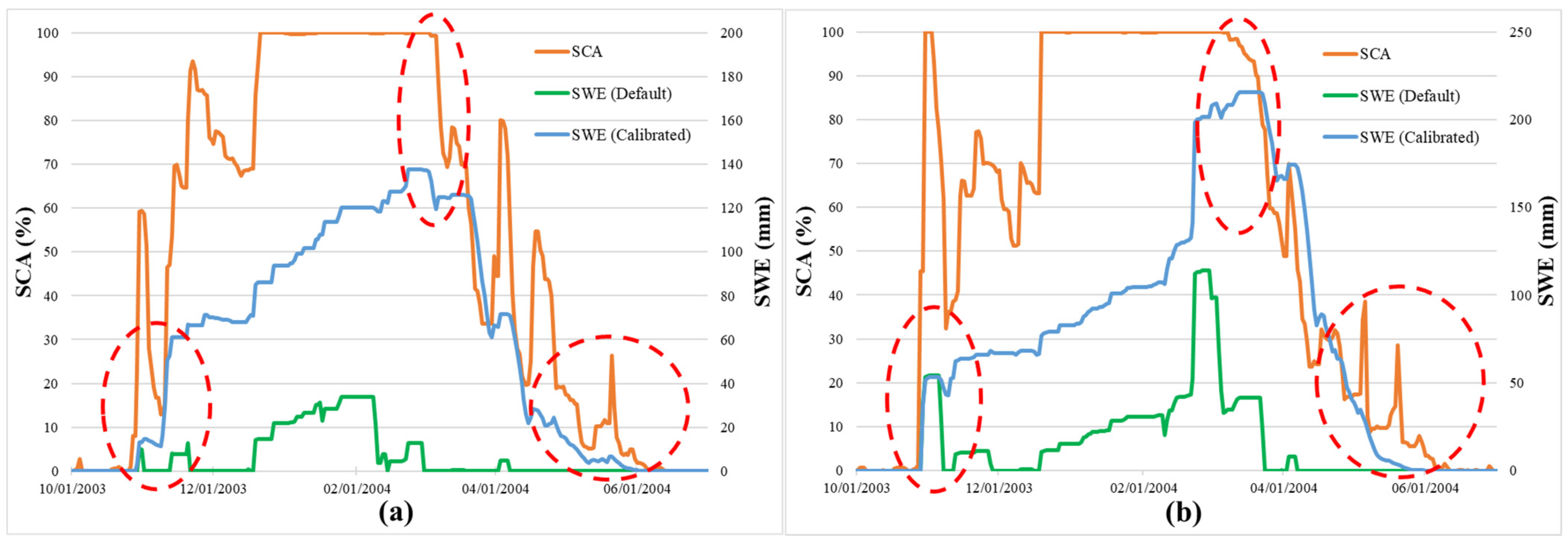
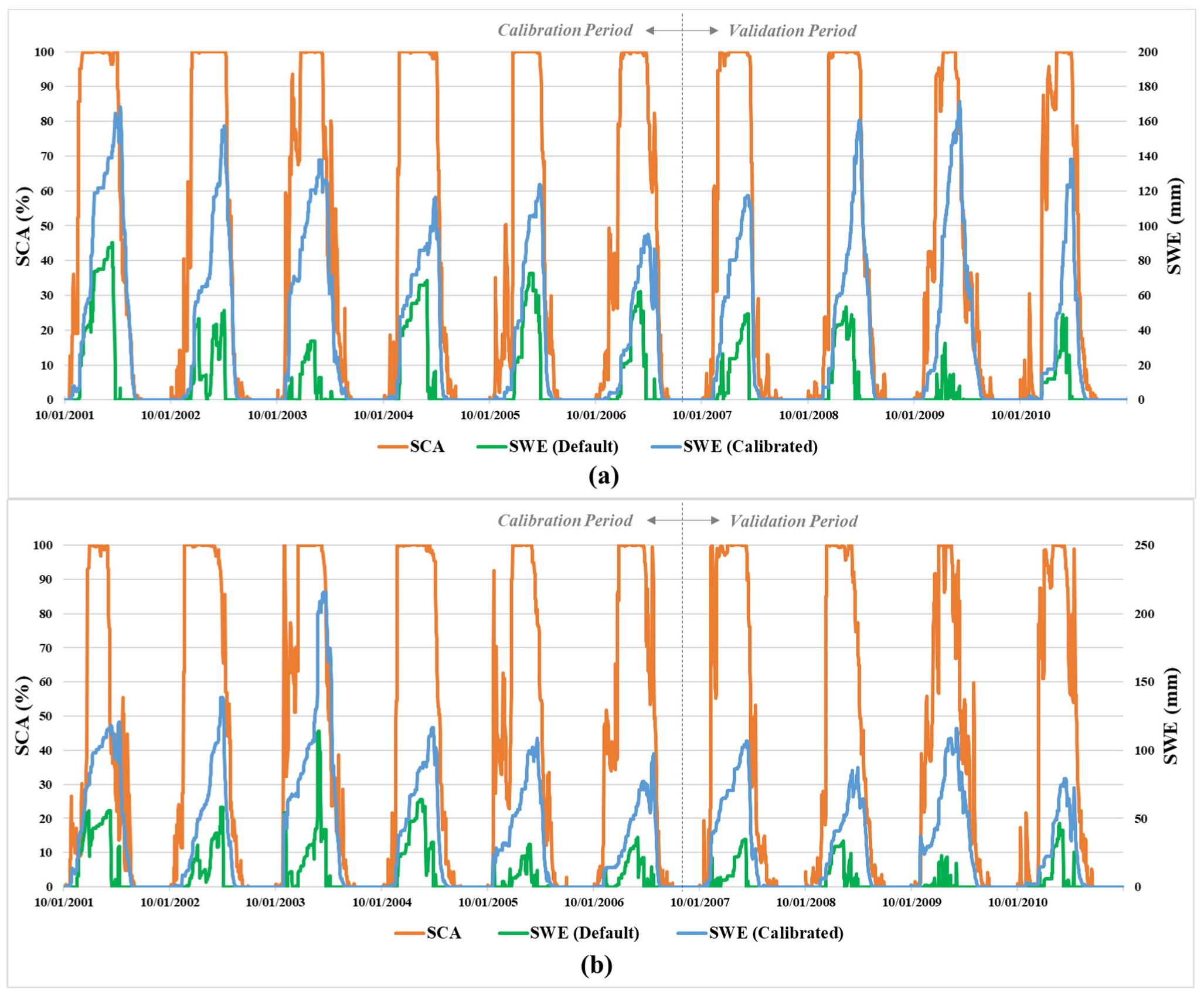
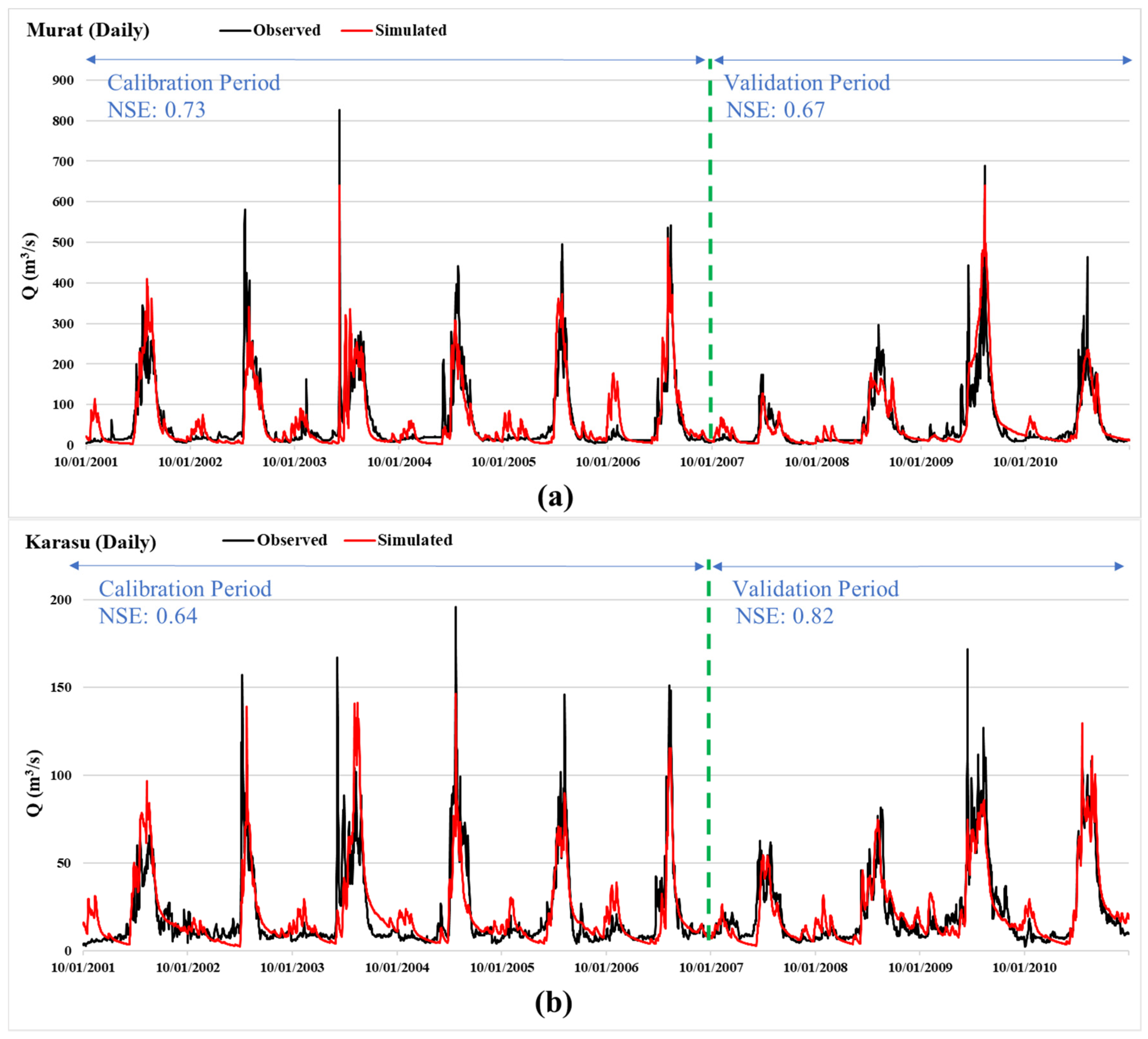
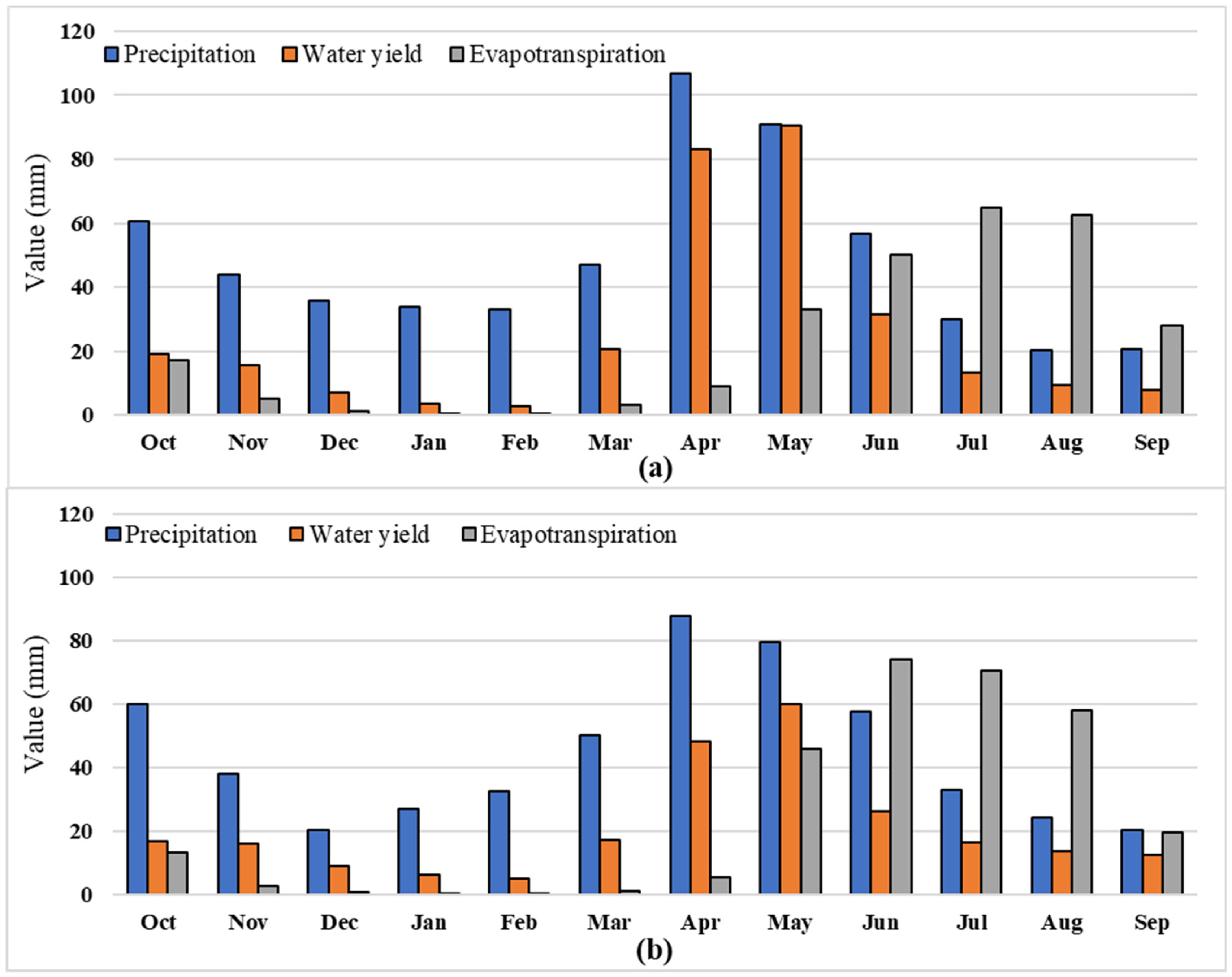

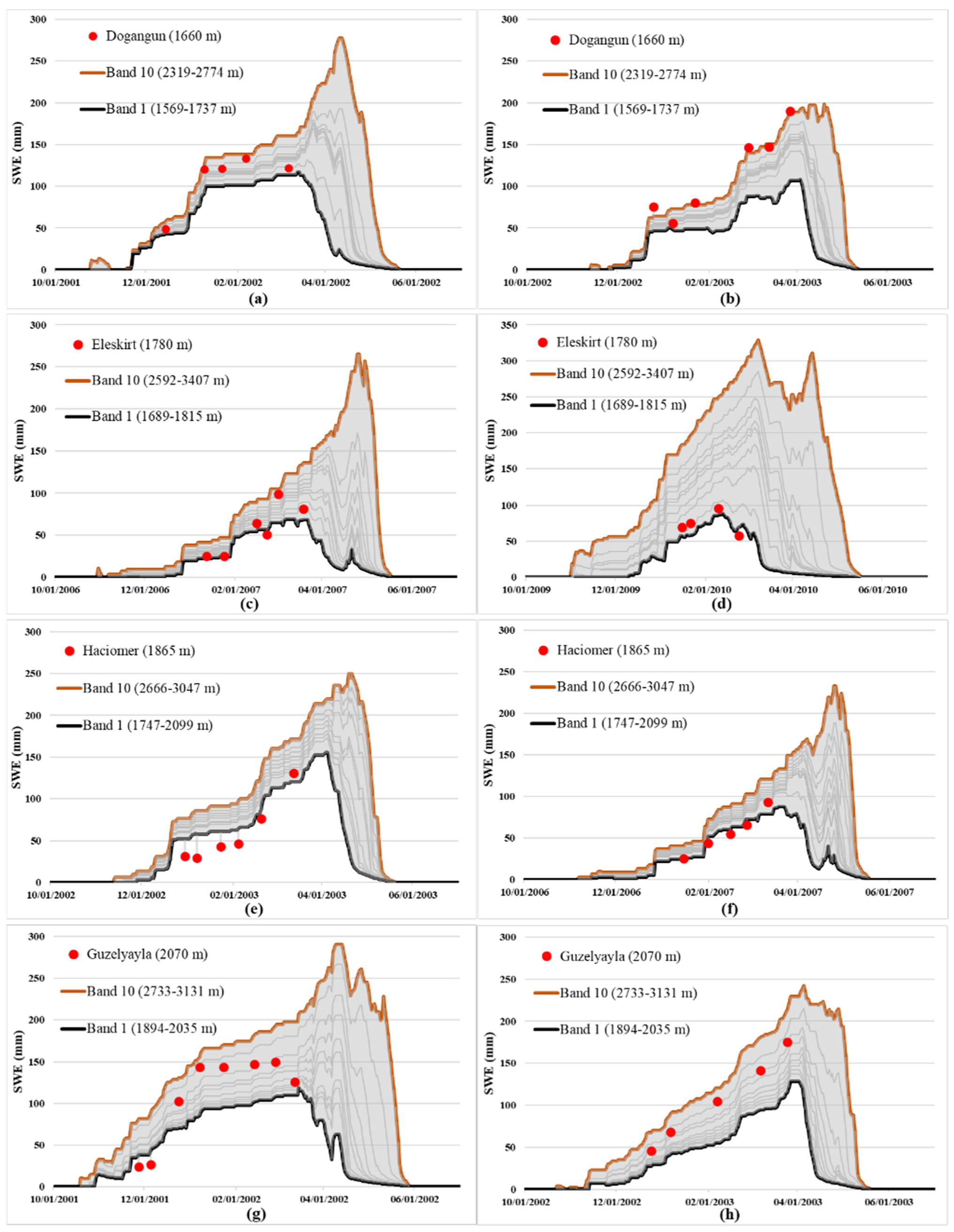
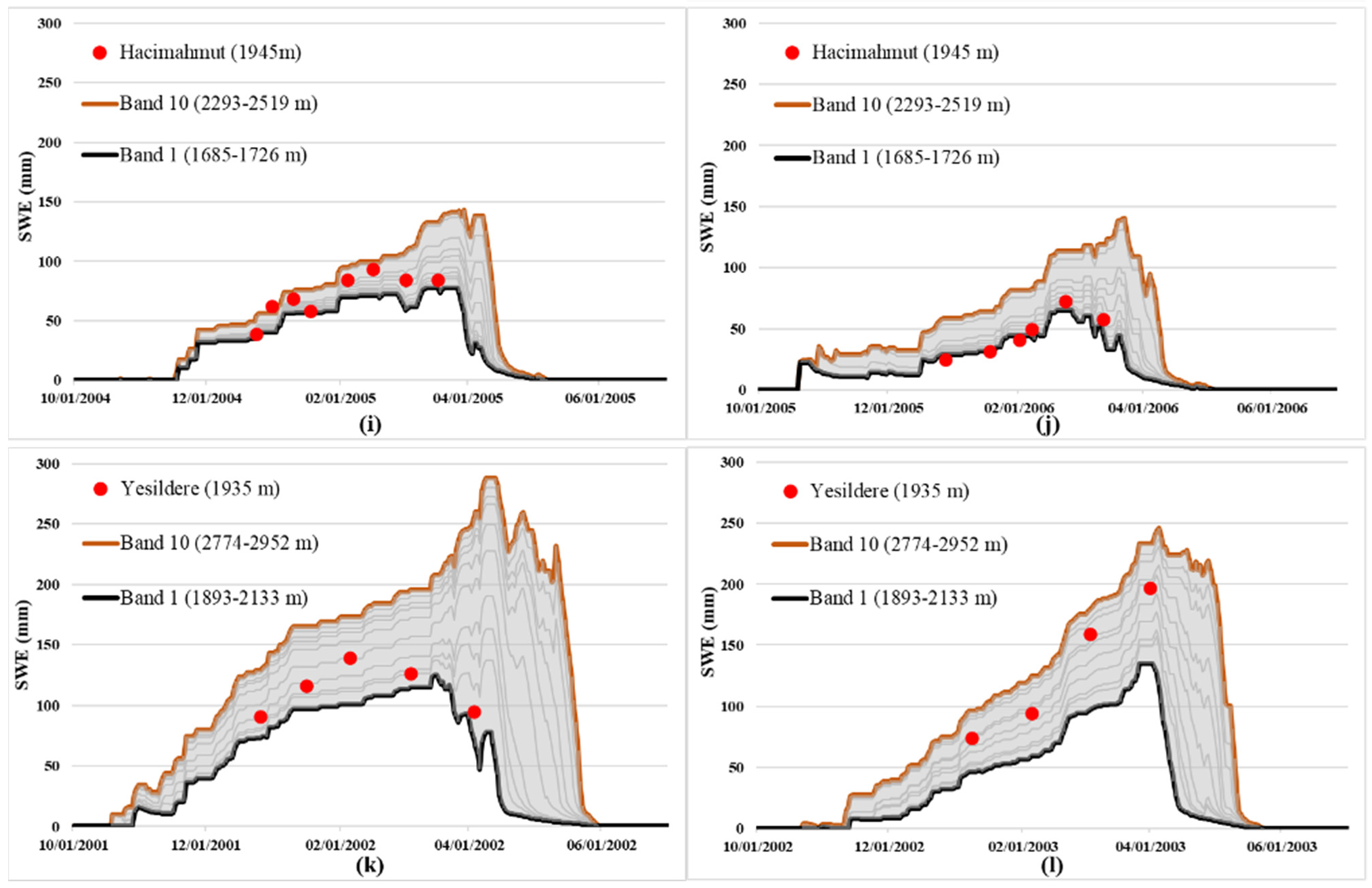
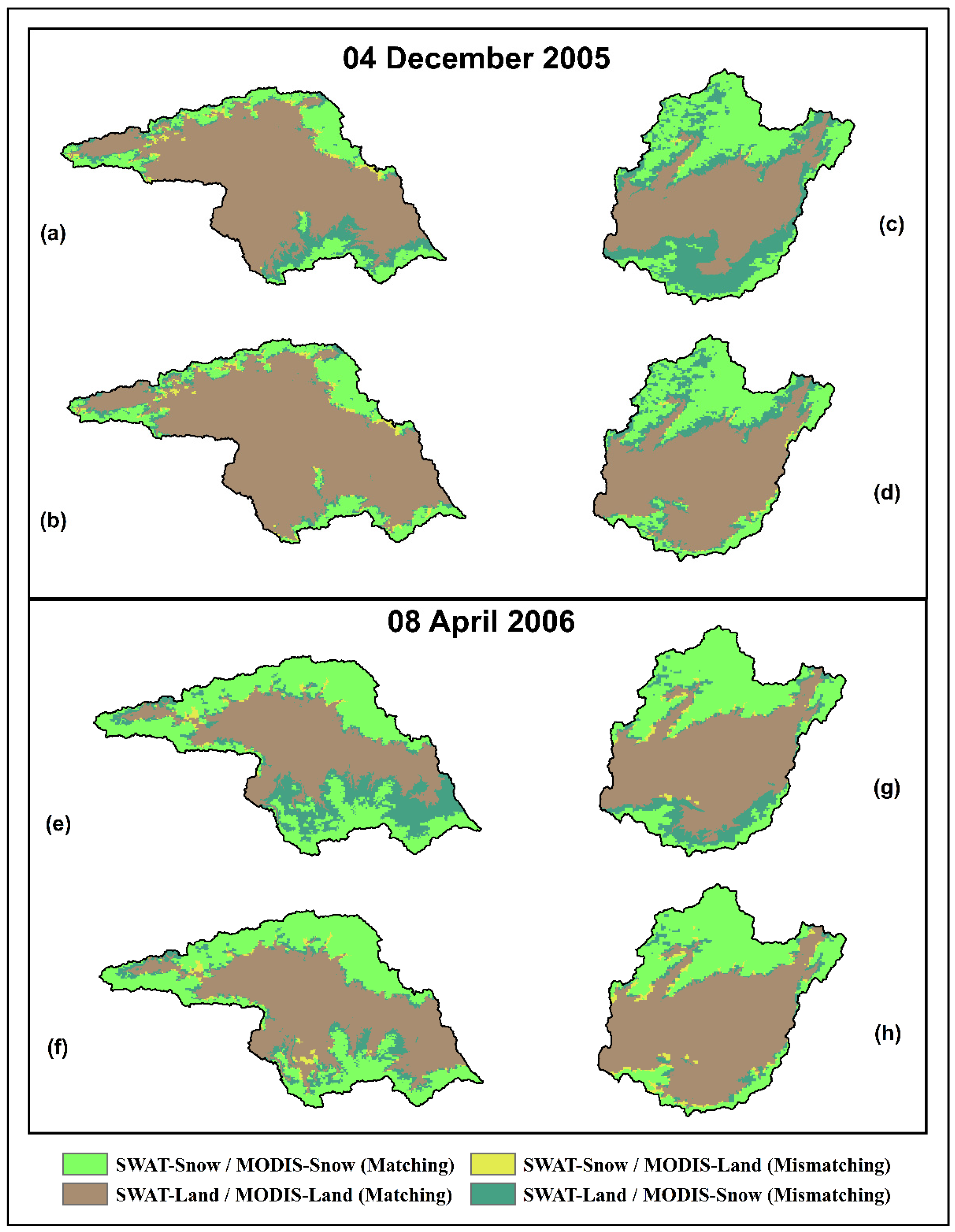
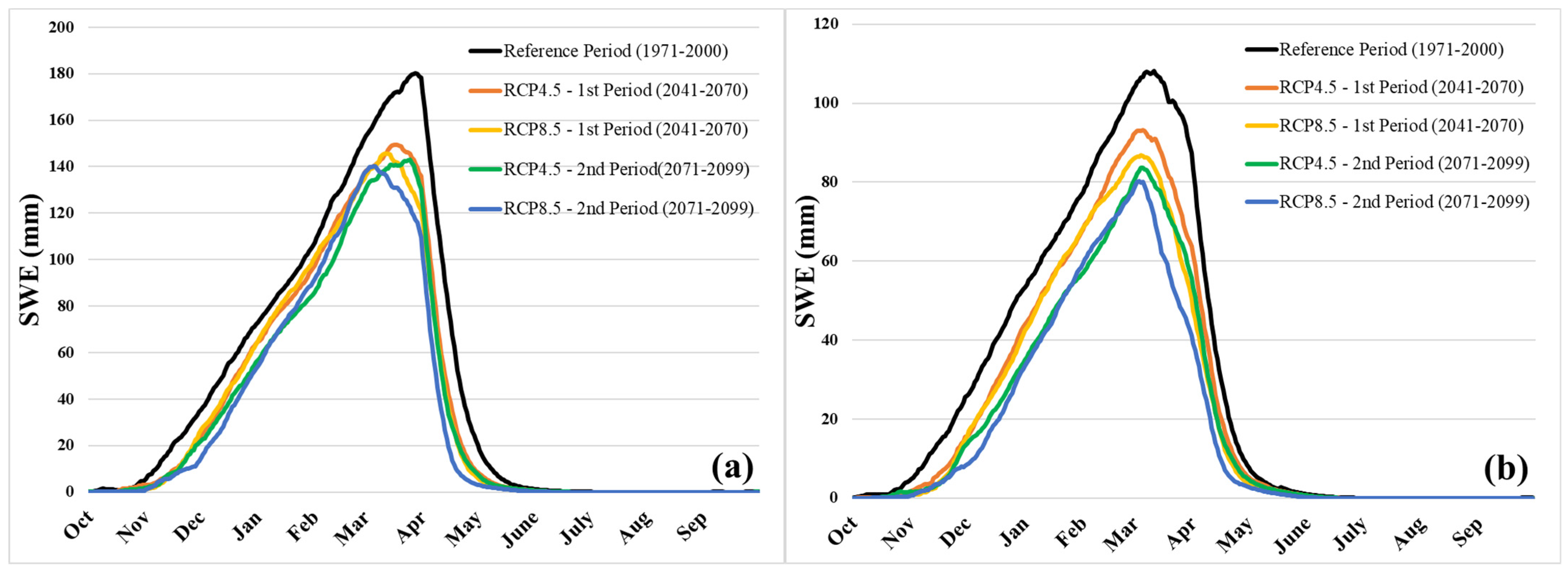
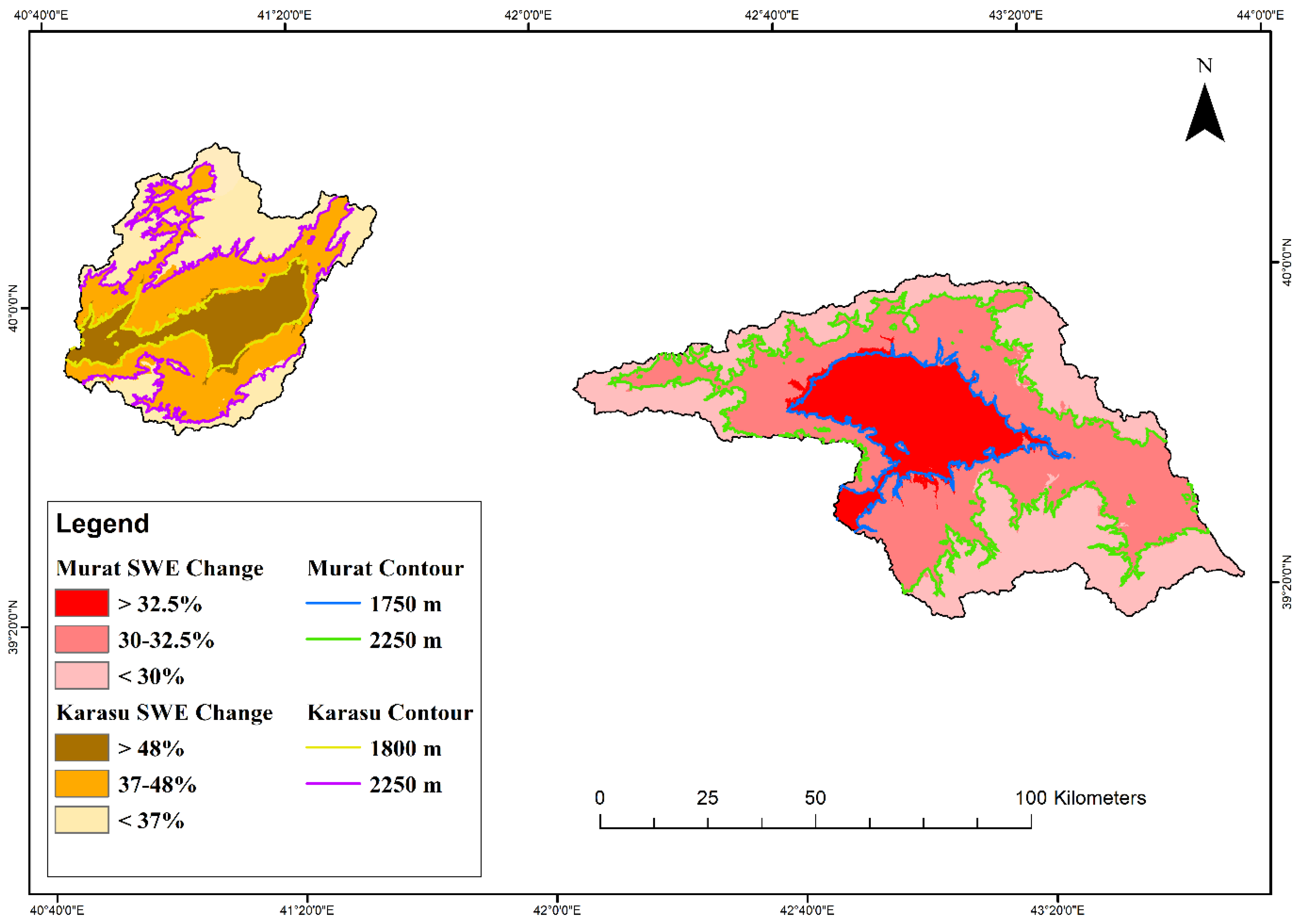
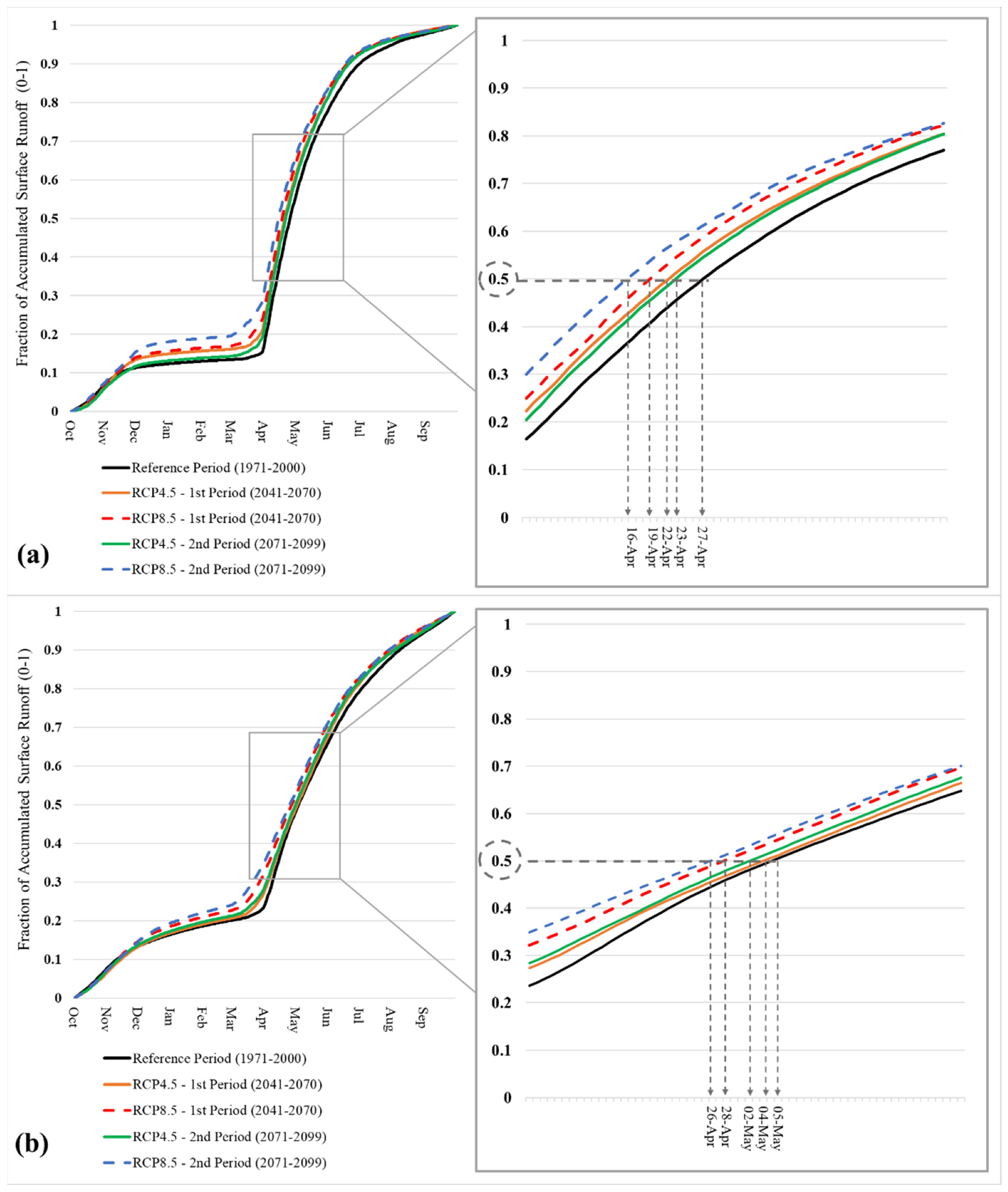
| Data Type | Data Source | Scale/Resolution |
|---|---|---|
| HRU Definition Data | ||
| Digital Elevation Model (DEM) | Shuttle Radar Topography Mission (SRTM) | Grid cell 90 × 90 m |
| Land use | European Environment Agency CORINE Land Cover (year 2000) | Grid cell 100 × 100 m |
| Soil | FAO-UNESCO Global Soil Map | Scale 1:5,000,000 |
| Climate Data | ||
| Precipitation, max./min. temperature | Turkish Meteorological Service (MGM) | Ground station |
| Rel. hum., solar rad., wind speed | Climate Forecast System Reanalysis (CFSR) | Grid cell ~38 km |
| Calibration/Validation Data | ||
| Discharge | Turkish Hydraulic Works (DSI) | Ground station |
| Snow Water Equivalent (SWE) | Turkish Hydraulic Works (DSI) | Ground station |
| Snow Cover Area (SCA) | MODerate Resolution Imaging Spectroradiometer (MODIS) | Grid cell 500 × 500 m |
| Climate Projection Data | ||
| Temperature/precipitation | Turkish Meteorological Service (MGM) | Grid cell 20 × 20 km |
| Description | Murat | Karasu |
|---|---|---|
| Minimum subbasin threshold area | 10,000 Ha | 5000 Ha |
| HRU threshold (slope/land use/soil) | 0/0/0 | |
| Subbasin number | 45 | 41 |
| Slope classes | 0–12/12–25/>25 (%) | |
| HRU number | 663 | 462 |
| Elevation band number | 10 | |
| Warm-up period | 1999–2001 (3 years) | |
| Calibration period | 2002–2007 (6 years) | |
| Validation period | 2008–2011 (4 years) | |
| Hydrological Year | Murat Basin | Karasu Basin | ||||||||
|---|---|---|---|---|---|---|---|---|---|---|
| a | b | c | d | Hit Rate (%) | a | b | c | d | Hit Rate (%) | |
| 2002 | 213 | 7 | 5 | 140 | 96.71 | 200 | 16 | 2 | 147 | 95.07 |
| 2003 | 179 | 8 | 9 | 169 | 95.34 | 184 | 2 | 33 | 146 | 90.41 |
| 2004 | 209 | 5 | 2 | 150 | 98.36 | 209 | 0 | 8 | 149 | 98.08 |
| 2005 | 179 | 7 | 10 | 169 | 95.34 | 183 | 6 | 9 | 167 | 95.89 |
| 2006 | 171 | 0 | 26 | 168 | 92.88 | 203 | 0 | 3 | 159 | 99.18 |
| 2007 | 193 | 2 | 5 | 165 | 98.08 | 193 | 0 | 9 | 163 | 97.53 |
| Total Cal. Period | 1144 | 29 | 57 | 961 | 96.07 | 1172 | 24 | 64 | 931 | 95.98 |
| 2008 | 157 | 2 | 19 | 188 | 94.52 | 180 | 11 | 23 | 152 | 90.96 |
| 2009 | 177 | 5 | 6 | 177 | 96.99 | 178 | 2 | 8 | 177 | 97.26 |
| 2010 | 198 | 6 | 3 | 158 | 97.53 | 194 | 4 | 8 | 159 | 96.71 |
| 2011 | 159 | 1 | 11 | 194 | 96.71 | 179 | 24 | 11 | 151 | 90.41 |
| Total Val. Period | 691 | 14 | 39 | 717 | 96.37 | 731 | 41 | 50 | 639 | 93.77 |
| Total | 1835 | 43 | 96 | 1678 | 96.25 | 1893 | 75 | 114 | 1570 | 95.15 |
| Parameter | Fitting Value |
|---|---|
| SFTMP | 1 °C |
| SMTMP | 0.5 °C |
| SMFMX | 2.5 mm H2O/°C-day |
| SMFMN | 0.5 mm H2O/°C-day |
| TIMP | 1 |
| SNOCOVMX | 55 mm H2O |
| SNO50COV | 0.55 |
| PLAPS | 175 mm H2O /km |
| TLAPS | −5.5 °C/km |
| Parameters | Description | Murat Basin | Karasu Basin | ||
|---|---|---|---|---|---|
| t-Stat | p-Value | t-Stat | p-Value | ||
| CN2 | SCS runoff curve number | 2.48 | 0.01 | −11.73 | 0.00 |
| ALPHA_BF | Base flow alpha factor | 35.05 | 0.00 | 6.18 | 0.00 |
| GW_DELAY | Groundwater delay | −6.88 | 0.00 | 4.57 | 0.00 |
| GWQMN | Threshold water depth in the shallow aquifer for return flow to occur | −1.29 | 0.19 | 2.18 | 0.02 |
| REVAPMN | Threshold water depth in the shallow aquifer for ‘revap’ to occur | 2.12 | 0.03 | 1.83 | 0.06 |
| RCHRG_DP | Deep aquifer percolation fraction | 1.41 | 0.15 | 9.81 | 0.00 |
| GW_REVAP | Groundwater ‘revap’ coefficient | −0.43 | 0.66 | 1.06 | 0.28 |
| ESCO | Soil evaporation compensation factor | −0.11 | 0.90 | −0.68 | 0.49 |
| EPCO | Plant evaporation compensation factor | −0.57 | 0.56 | −0.43 | 0.66 |
| CH_K2 | Effective hydraulic conductivity in main channel alluvium | 0.65 | 0.51 | 0.45 | 0.65 |
| CH_N2 | Manning’s “n” value for the main channel | −0.19 | 0.84 | 1.01 | 0.31 |
| CANMX | Maximum canopy storage | −0.71 | 0.47 | 0.17 | 0.86 |
| LAT_TTIME | Lateral flow travel time | −1.01 | 0.30 | 0.91 | 0.36 |
| SLSOIL | Slope length for lateral subsurface flow | 0.35 | 0.72 | 0.32 | 0.74 |
| SURLAG | Surface runoff lag coefficient | 0.67 | 0.50 | 0.52 | 0.04 |
| FFCB | Initial soil water storage | 0.06 | 0.94 | 1.36 | 0.17 |
| SOL_Z | Depth from soil to bottom of layer | −1.66 | 0.09 | 27.54 | 0.00 |
| SOL_AWC | Available water capacity of the soil layer | −1.28 | 0.20 | 6.27 | 0.00 |
| SOL_BD | Soil moist bulk density | 4.43 | 0.00 | 2.09 | 0.12 |
| SOL_K | Saturated hydraulic conductivity | −11.95 | 0.00 | 4.62 | 0.00 |
| Parameters | Change Method | Default Range | Initial Range | Calibrated Value | |||
|---|---|---|---|---|---|---|---|
| Lower Limit | Upper Limit | Lower Limit | Upper Limit | Murat | Karasu | ||
| CN2 | r_ | 35 | 98 | −0.3 | 0.3 | −0.28 | −0.16 |
| ALPHA_BF | v_ | 0 | 1 | 0 | 1 | 0.73 | 0.75 |
| SOL_Z | r_ | 0 | 3000 | −0.3 | 0.3 | −0.21 | 0.30 |
| SOL_AWC | r_ | 0 | 1 | −0.3 | 0.3 | 0.29 | 0.19 |
| SOL_K | r_ | 0 | 2000 | −0.3 | 0.3 | −0.19 | 0.30 |
| SOL_BD | r_ | 0.9 | 2.5 | −0.3 | 0.3 | 0.10 | 0.12 |
| GW_DELAY | v_ | 0 | 500 | 5 | 100 | 10.69 | 7.53 |
| RCHRG_DP | v_ | 0 | 1 | 0.2 | 0.5 | 0.36 | 0.40 |
| GWQMN | v_ | 0 | 5000 | 5 | 1000 | 172.85 | 155.04 |
| REVAPMN | v_ | 0 | 1000 | 500 | 1000 | 770.45 | 750.10 |
| Objective Function | Murat Basin | Karasu Basin | ||
|---|---|---|---|---|
| Calibration | Validation | Calibration | Validation | |
| NSE | 0.73 | 0.67 | 0.64 | 0.82 |
| R2 | 0.74 | 0.76 | 0.63 | 0.82 |
| PBIAS | −4.3 | −14.00 | 8.5 | −3.00 |
| Murat Basin | Karasu Basin | |
|---|---|---|
| Simulated WYLD (mm) | 304.2 | 246.3 |
| Observed WYLD (mm) | 294.2 | 244.2 |
| Water Balance Component | Volume (mm) | |
|---|---|---|
| Murat Basin | Karasu Basin | |
| Precipitation | 508.1 | 529.2 |
| Snowfall | 183.2 | 173.7 |
| Snowmelt | 170.1 | 168.3 |
| Sublimation | 17.0 | 10.0 |
| Surface runoff | 11.9 | 2.26 |
| Lateral flow | 5.1 | 5.6 |
| Ground water flow (Shallow aquifer) | 216.2 | 122.6 |
| Ground water flow (Deep aquifer) | 70.9 | 115.5 |
| Revap | 18.2 | 14.5 |
| Recharge from deep aquifer | 70.9 | 115.5 |
| Recharge from total aquifer | 294.1 | 238.2 |
| Total water yield | 304.2 | 246.3 |
| Percolation | 294.1 | 238.1 |
| Evapotranspiration | 274.8 | 290.9 |
| Potential evapotranspiration | 925.7 | 737.4 |
| Period | SWE Threshold Range (mm) | |||
|---|---|---|---|---|
| Murat Subbasin Groups | Karasu Subbasin Groups | |||
| North Side | South Side | North Side | South Side | |
| Accumulation Period (Oct-Dec) | 7–8 | 25–30 | 20–25 | 35–40 |
| 100% Snow Cover (Jan-Feb) | 20–25 | |||
| Recession Period (Mar-May) | 10–15 | 50–60 | 25–30 | 45–50 |
| Murat | Karasu | ||||
|---|---|---|---|---|---|
| ΔTmp (°C) | ΔPcp (%) | ΔTmp (°C) | ΔPcp (%) | ||
| 1st Period | RCP4.5 | +1.86 | −1.10 | +1.79 | +2.84 |
| RCP8.5 | +2.74 | −4.40 | +2.67 | −1.82 | |
| 2nd Period | RCP4.5 | +2.33 | −3.70 | +2.29 | −4.40 |
| RCP8.5 | +4.43 | −1.46 | +4.34 | +1.31 | |
| Murat | Karasu | ||||
|---|---|---|---|---|---|
| ΔSWE (%) | ΔSnow Days (day) | ΔSWE (%) | ΔSnow Days (day) | ||
| 1st Period | RCP4.5 | −18.70 | −19 | −19.64 | −18 |
| RCP8.5 | −20.95 | −23 | −25.78 | −22 | |
| 2nd Period | RCP4.5 | −25.56 | −22 | −31.82 | −22 |
| RCP8.5 | −29.84 | −43 | −38.83 | −37 | |
| Murat | Karasu | ||||
|---|---|---|---|---|---|
| Reference CT: 27-April | Reference CT: 5-May | ||||
| ΔQ (%) | CT/Shift | ΔQ (%) | CT/Shift | ||
| 1st Period | RCP4.5 | −0.57 | 22-April/5 days | +3.83 | 04-May/1 day |
| RCP8.5 | −4.23 | 19-April/8 days | −1.5 | 28-April/7 days | |
| 2nd Period | RCP4.5 | −2.73 | 23-April/4 days | −2.65 | 02-May/3 days |
| RCP8.5 | −1.18 | 16-April/11 days | +1.56 | 26-April/9 days | |
Publisher’s Note: MDPI stays neutral with regard to jurisdictional claims in published maps and institutional affiliations. |
© 2021 by the authors. Licensee MDPI, Basel, Switzerland. This article is an open access article distributed under the terms and conditions of the Creative Commons Attribution (CC BY) license (https://creativecommons.org/licenses/by/4.0/).
Share and Cite
Peker, I.B.; Sorman, A.A. Application of SWAT Using Snow Data and Detecting Climate Change Impacts in the Mountainous Eastern Regions of Turkey. Water 2021, 13, 1982. https://doi.org/10.3390/w13141982
Peker IB, Sorman AA. Application of SWAT Using Snow Data and Detecting Climate Change Impacts in the Mountainous Eastern Regions of Turkey. Water. 2021; 13(14):1982. https://doi.org/10.3390/w13141982
Chicago/Turabian StylePeker, Ismail Bilal, and Ali Arda Sorman. 2021. "Application of SWAT Using Snow Data and Detecting Climate Change Impacts in the Mountainous Eastern Regions of Turkey" Water 13, no. 14: 1982. https://doi.org/10.3390/w13141982
APA StylePeker, I. B., & Sorman, A. A. (2021). Application of SWAT Using Snow Data and Detecting Climate Change Impacts in the Mountainous Eastern Regions of Turkey. Water, 13(14), 1982. https://doi.org/10.3390/w13141982






